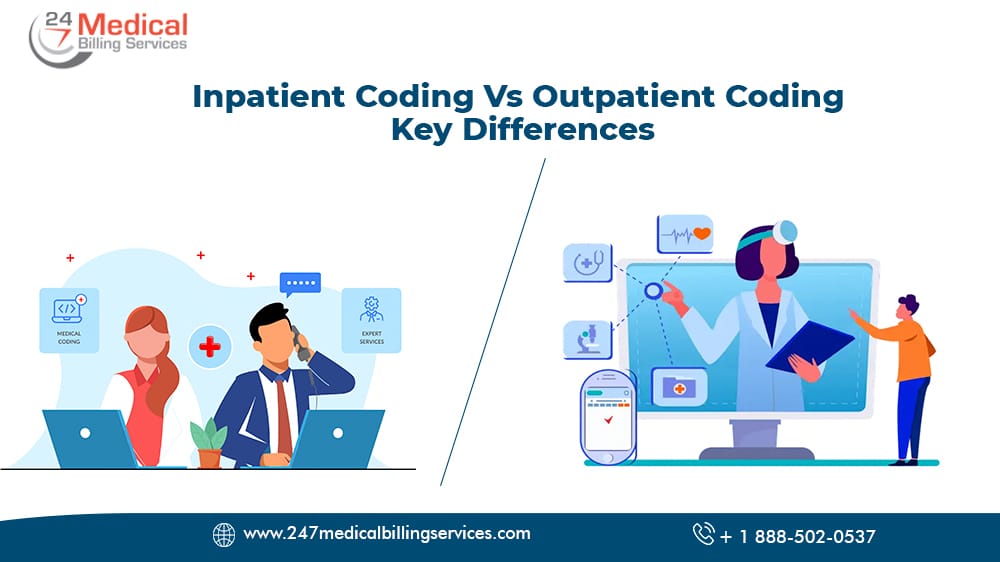
Inpatient Coding Vs. Outpatient Coding: Key Differences
Hospital billing and coding is a complex and time-consuming task. Many people working at the hospital ensure everything is well organized and systematic. Everything is a challenge, from the patient billing process to the reimbursement process. In fact, coding serves many functions, ranging from retrieving to reporting information based on diagnosis and procedure. One of the most critical medical billing and coding considerations is whether the patient is an inpatient or an outpatient. To understand the distinction between outpatient and inpatient coding, it is necessary to first comprehend these two terms in depth.
Inpatient Coding Vs. Outpatient Coding
- Meaning
The term "inpatient" refers to a patient formally admitted to the hospital on the doctor's orders. A hospital, rehab facility, nursing home, or long-term care facility may be where the patient is admitted for an extended stay. Staying in the hospital for the night does not automatically make a patient an inpatient.
The term "outpatient" refers to a patient treated but not admitted to the hospital for an extended stay. Outpatients are usually discharged from the hospital within 24 hours. Even when a patient remains in the hospital for more than 24 hours, and the physician does not write an order for their admission as an inpatient, the patient retains their outpatient status.
- Codes Used
The codes for reporting the patient's diagnosis and procedures done on inpatients are referred to as inpatient coding. Inpatient coding uses both the ICD-10-CM and ICD-10-PCS coding manuals. In the United States, ICD-10-PCS is only used in inpatient hospital settings. But ICD-10 PCS does not include lab tests, common procedures, or educational sessions separate from the inpatient hospital setting.
Outpatient coding uses ICD-10-CM diagnostic codes and CPT or HCPCS codes specific to services and supplies provided in the outpatient setting. One must remember that documentation is crucial in outpatient coding for assigning CPT and HCPCS codes.
- Stay Length
Inpatient codes document the full spectrum of services provided over a long period or during hospitalization. Present on Admission (POA) reporting is also required with inpatient coding. Present on admission refers to the conditions when the order for inpatient admission is issued. The POA indicator distinguishes between conditions present during admission and complications that develop during the patient's hospital stay.
Outpatient coding is more superficial than inpatient coding. Outpatient coding assigns codes based on the visit or encounter. Outpatient coding is used when patients receive treatment but spend less than 24 hours in a facility.
- Reimbursement
Many regulations and rules govern Medicare reimbursements and any co-pays the patient may be required to pay.
Inpatient services are covered by Medicare Part A (hospital insurance), which covers patients’ care in hospitals, hospital insurance, nursing home care, skilled nursing facility, hospice care, and home health care. Typically, inpatient services are coded using Medicare Severity-Diagnosis Related Groups (MS-DRGs). DRGs categorize patients based on their treatment, diagnosis, and length of hospital stay. A DRG is assigned based on variables such as primary diagnosis, secondary diagnosis or diagnoses, comorbidities and complications, surgical procedures performed, patient age and gender, and discharge status. In fact, complications and comorbidities (CC) increase the severity and cost of care episodes.
Outpatient services are covered by Medicare Part B, which covers medical expenses such as diagnostic tests, doctor’s visits, preventative care, and other outpatient care. In fact, outpatient services are coded primarily based on insurance contracted rates, physician fees, ambulatory surgical center rates, etc.
What Else?
- Billing
In inpatient coding, services are usually billed on the UB-04 form. On the other hand, services in outpatient coding are typically billed on the CMS-1500 form.
- Payment System
The inpatient prospective payment system (IPPS) is a reimbursement system that offers compensation. At the same time, the outpatient prospective payment system (OPPS) is a reimbursement payment method.
- Principal Diagnosis
In inpatient coding, the primary diagnosis is critical in determining the resources required by the patient and whether payments are completed thoroughly. But the term "principal diagnosis" is not used in outpatient settings because diagnoses are not established at the first visit.
- Coding for Uncertain Diagnosis
Uncertain diagnoses should be coded for inpatient admissions to long-term, short-term, acute care, and psychiatric hospitals during discharge. On the other hand, outpatient coding for the uncertain disease does not require any code. In fact, coders should refrain from inserting code based on their intuition.
- Complications
Under inpatient coding, if a patient needs to stay in the hospital for an extended period due to complications, this should be listed as the primary diagnosis. An additional code may be assigned if the difficulties do not match a specific diagnosis. While if the patient is admitted to the hospital due to complications from the surgery under the outpatient coding, the primary diagnosis for inpatient admission should be listed.
What’s Common in Inpatient Coding & Outpatient Coding?
In a nutshell, the foundation remains the same, but coders must stay current with changing hospital coding regulations to ensure compliance with both inpatient and outpatient guidelines. The hospital facility provides a variety of settings for claiming services, billing, and coding appropriately for reimbursement. The number of inpatient admissions or beds available for inpatient care is frequently used to determine hospital size. The rest is up to the coders, as codes differ from physician to physician and hospital to hospital.
Similarly, inpatient coding differs significantly from outpatient coding regarding guidelines, approach, payment system, and other factors. However, one common solution is to get 100% reimbursement for hospital billing services - inpatient and outpatient services, i.e., outsourcing coding to 24/7 Medical Billing Services.
See More : The Impact Of Incorrect Billing On Physicians And Their Practices

.png)